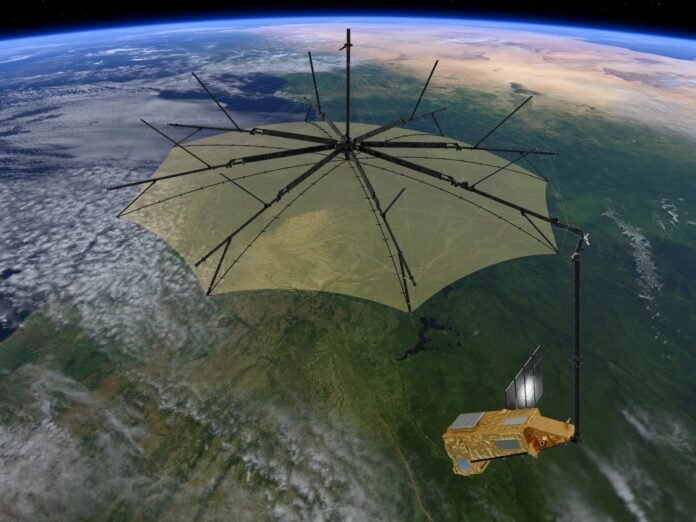
On April 29, 2025, a satellite unlike any other will launch into the silent void of space — not to gaze at stars or scan the oceans, but to listen to the whispers of the trees.
This is the Biomass mission, the European Space Agency’s latest venture into the living, breathing heart of Earth: its forests. Equipped with cutting-edge radar technology, this satellite will unravel the secrets of carbon, climate, and the colossal ecosystems that knit our planet together — one treetop at a time.
Why Forests Matter (More Than You Think)
Forests aren’t just scenic backdrops for postcards or vacation photos — they’re the planet’s lungs. These green giants absorb roughly 16 billion metric tonnes of carbon dioxide every year, acting as a natural buffer against the rising tide of emissions.
And yet, we’re losing them.
In 2023 alone, an estimated 3.7 million hectares of tropical forest vanished, releasing vast quantities of stored carbon into the atmosphere — about six percent of global CO₂ emissions in one go. Every tree lost is a breath held too long, a climate target slipping further out of reach.
The problem? We don’t even have a clear picture of how much forest biomass exists — let alone how fast it’s changing.
Enter: the Biomass satellite.
How the Biomass Mission Works
At the core of the Biomass mission is a marvel of remote sensing: a P-band synthetic aperture radar (SAR) operating at 435 MHz — a frequency powerful enough to penetrate deep through forest canopies and reflect back vital data about what lies within.
This is no ordinary radar. Unlike optical or higher-frequency radar systems, the P-band can see what others cannot — tree trunks, branches, root zones, even underbrush — essentially giving us X-ray vision for forests.
From its low Earth orbit, the satellite will circle the planet, capturing detailed 3D images of Earth’s woodlands. Over the next five years, it will track forest biomass, carbon storage, and even subtle shifts in forest structure with interferometric precision.
It’s like giving scientists a time-lapse lens on the world’s forests — one that finally fills the massive data gap in our climate models.
Looking Beyond the Trees
But forests aren’t the only thing this radar will watch.
The Biomass satellite will also keep a close eye on the ice sheets of Antarctica, tracking their slow, silent flow. It will map terrain hidden beneath thick vegetation, opening new frontiers in ecology, geology, and conservation. From monitoring remote jungles to shifting glaciers, its radar beams will gather stories untold.
In a world of accelerating climate change, this kind of multi-purpose Earth intelligence is nothing short of gold.
Part of a Larger Quest: The Earth Explorer Programme
Biomass is the latest chapter in the European Space Agency’s Earth Explorer Programme — a suite of missions designed to tackle Earth’s greatest mysteries using satellite science.
Let’s rewind for a moment:
- GOCE (2009–2013) mapped the Earth’s gravity field.
- SMOS still monitors soil moisture and ocean salinity to improve weather forecasts.
- CryoSat measures Arctic ice thickness.
- Swarm peeks into the planet’s magnetic heartbeat.
- Aeolus pioneered global wind monitoring.
- EarthCARE (launched May 2024) studies clouds and radiation for sharper climate predictions.
And after Biomass, the future looks even greener (and geekier):
- FLEX will track plant photosynthesis — yes, it’ll actually watch how plants breathe.
- FORUM will explore far-infrared radiation to refine climate models.
- Harmony will map Earth’s dynamic surface, from earthquakes to glacier flows.
Together, these missions form a space-based orchestra, each playing a unique tune about the planet’s systems, and together crafting a symphony of insight.
Why This Mission Matters Now
We live in an age of tipping points.
Forests are disappearing. Ice is melting. Climate systems are becoming more erratic. To navigate the future, we need not just more data, but better data — the kind that can pinpoint where carbon is stored, where it’s being released, and how ecosystems are evolving in real time.
The Biomass mission isn’t just about trees. It’s about understanding how life on Earth works, and how to protect it.
Because in the end, it’s not just about looking at Earth from space — it’s about seeing it more clearly than ever before.
When Biomass lifts off in April 2025, it won’t just be carrying radar equipment and antennas. It’ll carry the hopes of climate scientists, conservationists, and future generations — all banking on a better map to guide us through the forest of the future.

